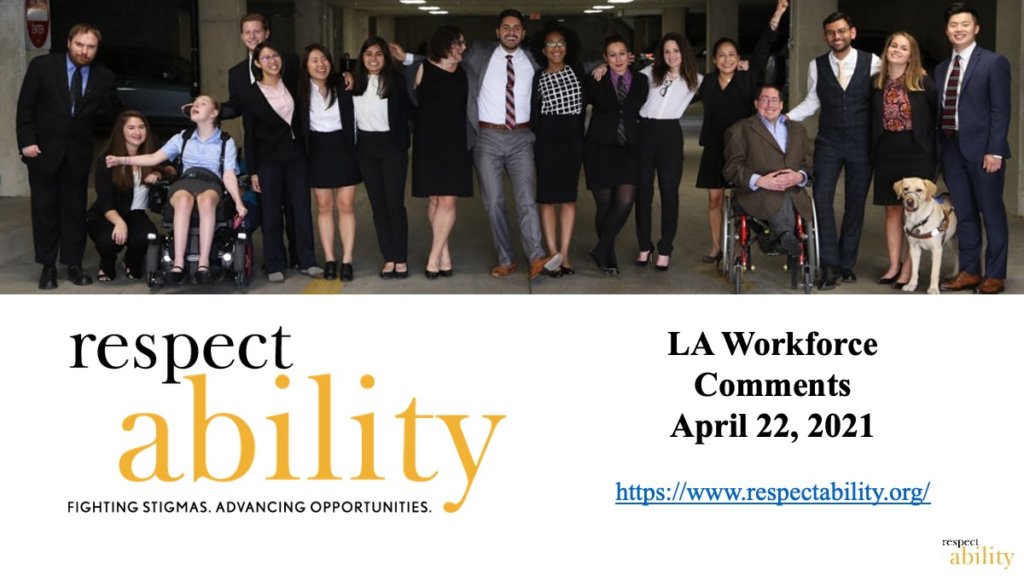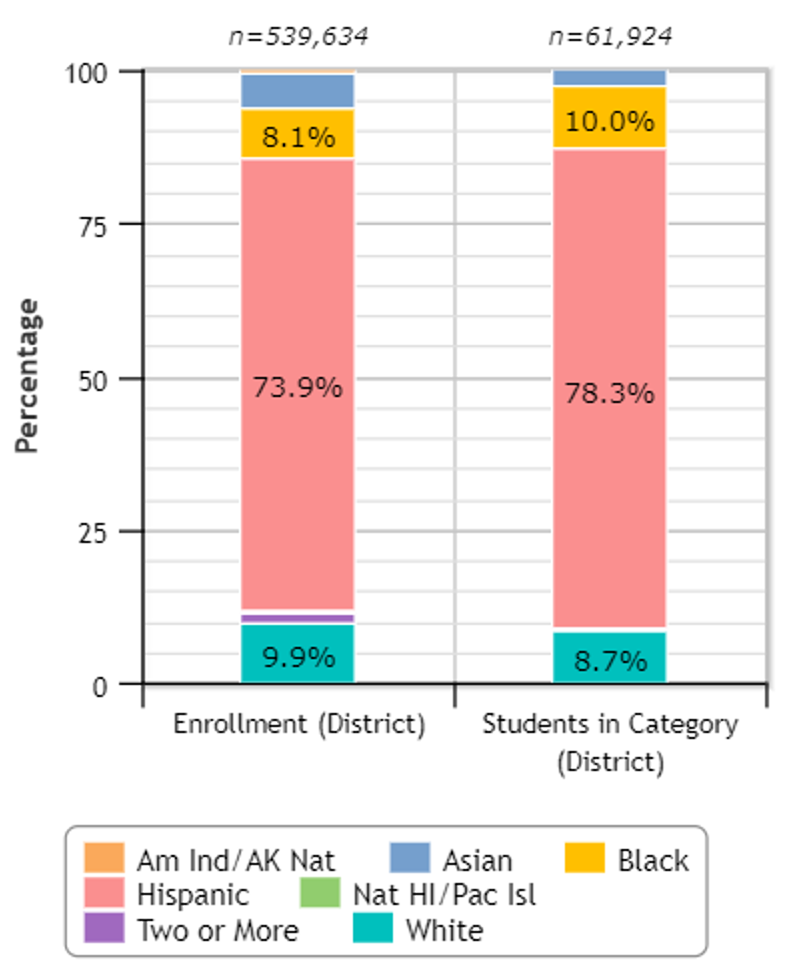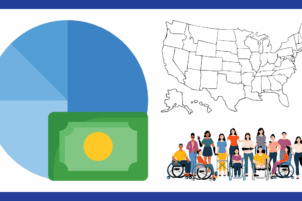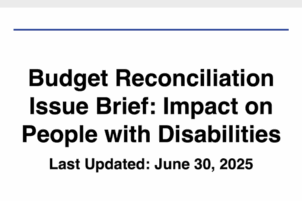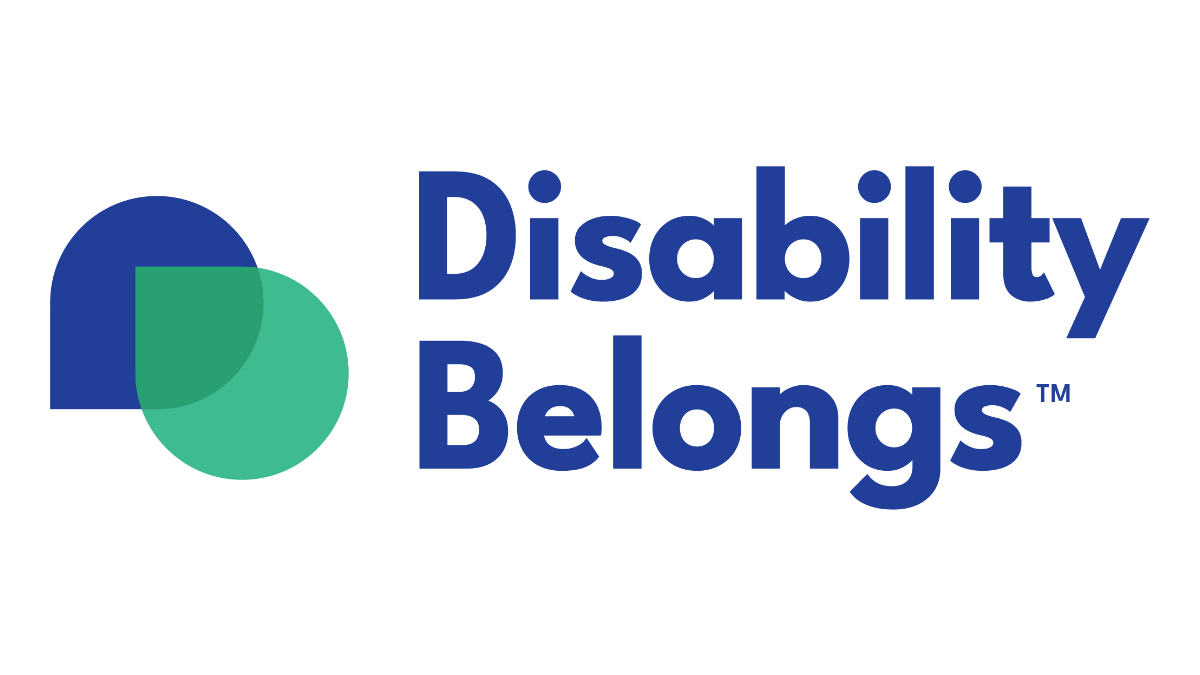Submitted testimony will help inform metro area efforts to rebuild the economy and get people with disabilities back to work.
Washington, D.C., April 28 – Last week, the Los Angeles Regional Planning Unit of the Los Angeles County Workforce Development Board invited subject matter experts, self-advocates, community members and their constituents to provide ideas about local and regional planning efforts to build a more equitable economy in a post-COVID world. In response, the national disability inclusion organization RespectAbility weighed in with their perspective on how to advance new opportunities for workers with disabilities and close crucial gaps in outcomes for people from marginalized communities.
“The Local Plan and the Regional Plan start out with an admirable goal,” said Nelly Nieblas, RespectAbility’s Manager of Policy, Advocacy and Engagement. “However, neither plan follows up on this aspiration by including people with disabilities in their demographic sections. There are multiple missed opportunities to include people with disabilities within the plans. We hope that we can partner with the Board to fix these challenges in the months ahead.”
In their comments about the Plans for the LA Basin Region and LA County Local Plan, RespectAbility’s team articulated the need to focus on people with disabilities, targeting performance metrics on closing gaps, leveraging community colleges and continuing to support remote work options even as more workers get vaccinated.
The entertainment industry and the transformative power of Hollywood was also highlighted in RespectAbility’s comments. “What we see and hear impacts our thoughts and feelings,” said Lauren Appelbaum, Vice President of Communications, at RespectAbility. “Authentic, accurate representation could remove stigmas that have long held people with disabilities back.”
RespectAbility’s full testimony is presented below:
To: Los Angeles Regional Planning Unit, Attention: Martha Molina-Aviles, Executive Director, Los Angeles County Workforce Development Board.
From: The Board of Directors, Senior Leaders and Staff Members, RespectAbility
Re: Public Comments on regional and local WIOA Plans for the LA Basin Region
Date: April 22, 2021
Dear Ms. Molina-Aviles,
RespectAbility, a nonprofit disability organization that fights stigmas and advances opportunities for people with disabilities, writes to submit public comment on the regional and local WIOA Plans for the LA Basin Region (“Regional Plan” or” RP”) and LA County Local Plan (“Local Plan” or “LP”) from 2021 to 2024.
RespectAbility is a national nonprofit that focuses on the disability community. However, since 2017, we have been working extensively throughout the wider Los Angeles metropolitan area and we have gained critical organizational understanding about the challenges faced by planners in L.A. We have actively collaborated with the California Economic Development Department, the Department of Rehabilitation, the City of Long Beach, and the City of Los Angeles itself.
However, during the pandemic we dramatically expanded to meet the needs of people with disabilities, and we continue to address the pandemic related challenges faced by the disability community.
As an overall observation, we note that although people with disabilities are a specific subcategory identified in many of the exciting programs and opportunities mentioned in these plans, these plans do not fully explore what is needed for the workforce success of 452,879 working-age people with disabilities in Los Angeles County and 185,973 working-age people with disabilities in the City of Los Angeles. Today the labor force participation rate of working age Angelenos with disabilities is only 22 percent, which is significantly lower than the pre-pandemic national average of 38.8 percent. Thus, we are writing with many ideas for how this ambitious Regional Plan could be beneficial for workers with disabilities and the lives they touch. We strongly encourage you to make these changes so that people with disabilities can have jobs and a better future, just like anyone else, and so Los Angeles can benefit from the considerable talents of people with disabilities.
We have broken up our topics thematically with reference to both plans.
The Plans Must Expressly Include a Focus on People with Disabilities
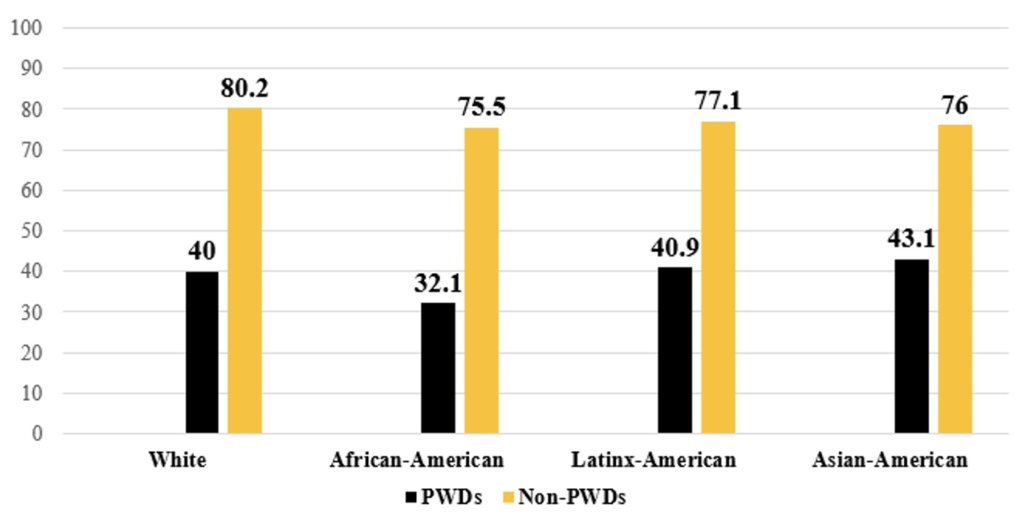
Figure 1: Employment Rates for Working-Age Americans w/ & w/o Disabilities, by Race – 2019 (Pre-COVID). Source: 2020 Annual Disability Statistics Compendium
Almost from the onset, the need to use good disability data becomes apparent, as well as the need to make sure that disability data is included within both plans. The Local Plan starts out with an admirable goal, “In support of regional economic growth and economic self-sufficiency, the County WDB’s Local Plan reflects a commitment to a vision that everyone in Los Angeles County has access to sustainable employment and increased income mobility, and every business has the talent they need to succeed in a global economy”. (LP. p 6) Yet, neither plan follows up this aspiration by including people with disabilities in their demographic sections. In fact, when the Local Plan refers to a common customer pool on LP p. 22, there are 15 potential pools identified, but people with disabilities are not included. We do note that that same section then does refer to providing accommodations on the top of p.24, but there is little indication that people with disabilities are really being thought of as a population. The data must also show disaggregated data, so we know how things are progressing as Los Angeles works to reduce the effects of ableism and racism.
The gap in including the important intersection between disability and the issues tracked continues throughout. In the first paragraph on Regional Plan p. 1, there is an impressive breakdown of the income disparity between LA County and the rest of the state, but the Regional Plan does not mention that while 13.4 percent of LA County residents are living in poverty, for LA County residents with disabilities, that number jumps to 25 percent. The Regional Plan’s following paragraph appropriately recognizes the disproportionate impact on people of color and English language learners but does not reference the percentage of people in LA County for people with disabilities; another disproportionately affected group. For reference, that percentage is 9.9 percent.
On RP p. 2, it notes that at the height of the pandemic, the unemployment rate in the county jumped from 4.5 percent to 20.8 percent. We urge that the report also note the disability unemployment rate, which was already more than double that of the general population at 10.5 percent pre-pandemic. Likewise, we believe that looking at the labor force participation rate is a better metric of the economy, and better reflects those who are striving to work or already have jobs. As such, it is critical to note that as of March 2021, 76.1 percent of people without disabilities were engaged with the labor force nationally, compared to people with disabilities at 33.4 percent. Closing this gap is a crucial measure which we hope will guide your future workforce efforts.
On RP p. 5 you note that 58 percent of those who left the labor force by January 2021 were women but failed to note the equally impactful reality that a high percentage of the individuals who left the labor force were people with disabilities. To the extent that we do not have that data, it in fact shows the importance of tracking these rates for individuals with disabilities as we continue with the Regional Plan workforce efforts.
On RP p. 6 a similar challenge can be found in the discussion of educational attainment, which rightfully breaks down the disparities by race but fails to show that the gaps are even more profound for people with disabilities. For example, while Los Angeles Unified School District (LAUSD) students without disabilities have an 81.3 percent high school graduation rate, Los Angeles students with disabilities have a high school graduation rate of only 63.7 percent.
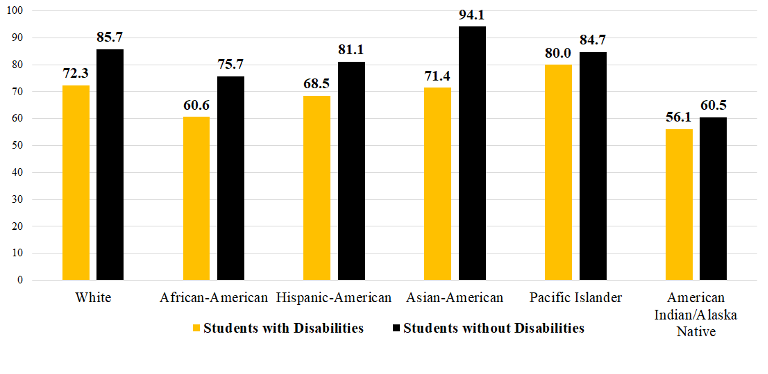
Figure 2: Graduation rates for Los Angeles Students with and without disabilities, by race. Source: 2018-19 Four-Year Adjusted Cohort Graduation Rate LA County Report
Further, it is critical to recognize that the students enrolled in LAUSD’s special education programs reflect the diversity of the Los Angeles metropolitan area. Out of the approximately 191,000 students with disabilities enrolled in LAUSD’s K-12 system, fully 78.3 percent are Latinx, 10 percent are African American, and only 8.7 percent are white. Fully 11.5 percent of LAUSD students are students with disabilities and their unique needs require support, investment, and focused programmatic efforts. Lastly, in terms of the intersectional identities of LAUSD’s students with disabilities, it is worth recognizing that 26.8 percent of LAUSD students have Limited English Proficiency (LEP) and that number increases to 46.6 percent when looking at students with disabilities. Meeting the educational needs and employment aspirations of these students will require closer cooperation between workforce programs and the area’s educational authorities.
This Focus Must Be Reflected in Your Performance Goals
We congratulate the County on meeting its performance goals as outlined on LP 35 and 36, regarding youth, adults, and displaced individuals. However, given the disproportionate employment disparities for people with disabilities, and especially BIPOC people with disabilities, the County should also establish clear educational and employment goals for these populations.
The Plans Must Expressly Focus on Academic Achievement and Opportunity for People with Disabilities to Work by Leveraging Community College Resources to Improve Employment Outcomes for Students with Disabilities
The Regional Plan spends the entirety of pages 5 and 6 focusing on educational attainment, precisely because of the importance of this attainment in employment. And yet, as mentioned in the previous section, outcomes for people with disabilities continue to lag the general population. Community colleges are crucial pieces of the nation’s workforce development infrastructure and help direct the investment of WIOA dollars in programs or agencies in many states.
Leverage the Potential Impact of Community Colleges to Support Students with Disabilities
State and local Workforce Investment Boards can build sector partnerships that leverage community colleges and other education and training providers to develop career pathways that align workforce supply and demand. WIOA emphasizes the value of recognized postsecondary credentials, and the attention given to career pathways in the act provides a way for community colleges to contribute to the growth of skilled and credentialed workers in their local areas.
Community colleges in California received state funding for Disabled Student Programs and Services (DSPS) to assist in providing support services and educational accommodations to students with disabilities so they can have full and equitable access to the community college experience. Part of the community college experience can include job training and readiness. The Rehabilitation Act of 1973 (Act), as amended by WIOA emphasizes the provision of services to students and youth with disabilities to ensure they have opportunities to receive the training and other services necessary to achieve competitive integrated employment. It also expands the population of students with disabilities who may receive services and the kinds of services that the VR agencies may provide to youth and students with disabilities who are transitioning from school to postsecondary education and employment. Making the connection/partnership with Disabled Student Programs across every state with WIOA Eligible Training Provider programs at community colleges creates a pipeline of trained/certified workers with disabilities ready for the local competitive integrated job market.
On pages 23 and 24, the Regional Plan talks about several powerful initiatives to reconnect youth to schools and colleges, which includes mention of justice involved, homeless, and TANF youth. This is fantastic, but again leaves behind the critical population of people with disabilities. The Regional Plan must ensure that people with disabilities are included in these innovative programs. Indeed, many people with disabilities are contained in groups of people who are homeless and/or justice involved, and they need specific strategies and goals that will enable them to succeed.
People with Disabilities Need to Be a Part of Economic Recovery Efforts
The Regional Plan admirably recognizes that the massive disruptions in the labor market must be taken as an opportunity to help individuals re-skill workers and assist them onto new career paths, but while the Regional Plan says “The LABRPU will be vigilant in identifying those opportunities as they arise” on RP p. 10, the entire section fails to explore opportunities for individuals with disabilities. Similarly, the Local Plan lays out seven principles, (LP p.7) but none of these principles appear to embrace people with disabilities.
Three of the principles, (the focus on disproportionately impacted individuals, the focus on access to technology, and the coordination of co-location services) have very specific disability implications, but as we will see in our further discussion of the County and Regional plans, the needs of this community are not considered.
In fact, The Local Plan set aside $1 million “of WIOA Title I Adult and Dislocated Worker training dollars to facilitate the creation and implementation of novel training programs to prepare County residents, particularly those with multiple barriers to employment, for careers in high growth sectors. The WDB focused this year’s funds to mitigate the uncertainty we are currently facing with a high unemployment rate and thousands of impacted businesses because of the pandemic.” (LP p. 8) Yet there is no indication that people with disabilities were considered as a part of these funds that were set aside, despite the need for novel training programs. It is important to remember that in addition to rehabilitation, people with disabilities who were already working were disproportionately impacted and displaced by the pandemic.
It is true and laudable that the region has launched a pilot program to train individuals with intellectual and developmental disabilities in Glendale, as is mentioned on RP p. 21 and 22, but while such small programs are interesting, and the 88 percent placement rate is amazing, the Regional Plan fails to address twin realities: first, people with disabilities can work in any industry where the board has taken an interest. Secondly, small, targeted programs, even if replicated as the Regional Plan suggests, will not be enough to serve the tremendous numbers of people with disabilities that are looking for jobs.
The Local Plan is even more sparse, for despite lifting 10 specialty plans on LP p. 11-13, including programs for people experiencing homelessness, veterans, justice involved individuals, and youth, there is no mention of programs to serve people with disabilities. In fact, even within these programs, which experience high overlap with the disability community, there is no discussion of their ability to serve people with disabilities. In fact, the only partner specifically listed in the plan for serving people with disabilities is the Department of Rehabilitation. (LP p.18). While much of the work of DOR is exemplary, they also can benefit from even further partnerships with the disability community, providers, employers, and other stakeholders.
We feel that in addition to the stated programs, the plan should consider working even more extensively with successful disability employment programs in California. The models worth your attention to significant expansion are Project SEARCH and Bridges from School to Work. Project SEARCH is a transformational school-to-work transition program for youth with intellectual and developmental disabilities that prepares them for good paying careers in hospitals, elder-care, and the Caring Economy. It is a key part of the Caring Economy that we have heard so much from the White House recently. The SEARCH model is a win-win-win for the host employer, the workers with disabilities, and the many older Americans helped by Project SEARCH trained workers. As a model it has already been replicated in 47 states, with hundreds of satisfied employers, and thousands of workers with disabilities earning minimum wage or more. This model is perfectly suited to the challenges of the present and could be expanded widely. Likewise, through Bridges, over 15,000 youth with disabilities have been placed with over 4,500 employers.
Both models offer proven strategies for businesses to incorporate the talents of students with disabilities into the workforce. Locally, there are SEARCH sites worth visiting at the Kaiser Permanente LA Medical Center, Kaiser Permanente West LA Medical Center, and the Ronald Reagan UCLA Medical Center. Currently, the Los Angeles office of Bridges coordinates with LAUSD, the Compton Unified School District and L.A. County Office of Education – LA South Bay District.
Outside of disability-specific programs, there are multiple opportunities to include people with disabilities that seem to be missed within the plans. For example, on RP p. 12, the Regional Plan lists Construction, Healthcare, and Transportation and Warehousing as places of opportunity. On pages 15 through 19, the Regional Plan list out various apprenticeship programs in these fields, and while different programs appear to focus on race, re-entry, homeless individuals, veterans, and disconnected youth, (RP p. 16) as well as single parents, jobseekers have not completed high school, and women, (RP p. 17) nowhere does it mention people with disabilities being a part of your apprenticeship program. There is a similar lack in the discussion of the County apprenticeship plan. (LP p.7) It is urgent for this to be fixed. In fact, apprenticeship, including virtual apprenticeship for knowledge workers, is a powerful model, especially for people with disabilities, and especially as more work, including some of the case management work referenced in the Regional Plan, can be done virtually.
Continuing to Support Remote Work, even in a Post-COVID Working World
The pandemic’s expansion of virtual work has made this a key strategy for people with disabilities, by expanding and normalizing a common reasonable accommodation request long championed by workers with disabilities. Microsoft, for example, has dramatically expanded their accessibility features, including built-in speech to text technology which makes it possible for people with even the most limited mobility to use computers. Zoom now offers instant live captioning, which opens a new world of opportunity for people who are Deaf or Hard of Hearing. Technological progress has opened an unprecedented window for people with disabilities to contribute to the success of nonprofits, communities and beyond.
Remote work also has great promise at expanding apprenticeship programs into more diverse sectors of the American economy, especially the knowledge economy. RespectAbility has retooled our own National Leadership Program from being a cohort-based, in person internship program into an all-virtual, work-from-anywhere skills-based training program. RespectAbility has innovated an online apprenticeship program for people with disabilities to work in Entertainment Media. We invite you to do a site visit on Zoom and to provide support for such programs in the future as we and/or others could expand or replicate these cohort-based job placement programs for diverse people with disabilities. Such approaches have major implications for efforts to train workers for good paying jobs in the knowledge economy and the non-profit sector.
At the same time, to truly achieve this goal, the plans must ensure that they both stand behind the County’s stated prioritization of addressing the digital divide (LP p. 9) includes people with disabilities, who in addition to assistive technology often need help simply to obtain modern computers and affordable Internet.
The Plans Must Embrace a Broader Set of Target Industries
The Local Plan has a paragraph that indicates a desire to better serve people with disabilities, but the strategies include nebulous promises to “identify and implement best practices,” on targeted efforts such as “regular meetings with Regional Centers to educate our AJCC’s” and bare minimum practices like promoting accessible job postings. (LP p.25) Much like the far more targeted efforts for other populations in the plan, we recommend some specific targets be adopted around disability.
The Huge Potential of the Entertainment Industry for Jobs and to Reduce Stigmas that are Barriers to Work
The focus on the three industries in the previous paragraph belies other opportunities. For instance, on RP p. 11, the Regional Plan appropriately identifies that Entertainment and Infotech remain areas of powerful opportunity for job growth, and yet it does not appear anywhere in the substance of the Regional Plan. This is a missed opportunity given the unique potential created by the increased investment by Hollywood studios and employing people with disabilities.
What people see on-screen impacts what they think, feel, and do. This includes perceptions around if employers are willing to even imagine hiring qualified people with disabilities. Stigma dampens disability employment in every employment sector. However, our previous success with placing participants in employment at major Hollywood studios (discussed below) has shown that people with disabilities are just as capable as people without disabilities – and when it comes to advocating for accurate representation, even more so. And by showing people with disabilities on screen as individuals who are capable in a variety of careers, we can impact employment broadly.
Los Angeles County is home to Hollywood, the capital of the Entertainment industry in the U.S., and, to a great extent, the world. In 2018, there were 740,000 wage and salary workers in entertainment and digital media. The sector added 138,000 wage and salary jobs between 2013 and 2018, signifying a growing industry. Nearly half of these jobs are in film production, while emerging digital media and broadcasting account for nearly 25 percent. The industry has lost approximately 284,000 creative jobs because of the pandemic. However, Hollywood is rapidly accelerating plans to rebuild the creative economy and further expand production schedules to meet consumer demand.
The best source of accurate portrayals is authentic real-world experience, so there is a virtuous circle: increasing the number of people with disabilities working in the entertainment industry leads to more diverse and authentic representation on screen, further reducing stigma and increasing employment in all sectors. This is a prime opportunity to improve the disappointing statistics because (although the pandemic has put some productions on hold) projects are being pipelined for development. Likewise, more animation projects are being greenlit. Therefore, as writers and animators are being hired, our program will help ensure that people with disabilities are filling these roles to create this systemic change. Despite the pandemic, our proven virtual model provides an opportunity to move the needle in Hollywood.
Even though 25 percent of adults in America has a disability, only 3.5 percent of series regular characters on television have a disability (Where We Are On TV, GLAAD, 2020). In film, there has been no meaningful change in the percentage of speaking characters with disabilities, with just 2.3 percent of characters analyzed in the 100 top-grossing films of 2019 by the USC Annenberg School having a disability. While statistics for disability representation for people working behind the camera are not available, our extensive experience working with the industry confirms the numbers are similarly disheartening.
The representation that does exist is misleading. Almost all portrayals of people with disabilities in media are white, but disability impacts all. Anyone can join the disability community at any point and people with disabilities come from all communities – including African American, Asian, Hispanic, Indigenous, LGBTQ+ and other communities. According to Nielsen Research, consumers with disabilities represent a $1 billion market segment. When you include their families, friends, and associates, that total expands to more than $1 trillion. Americans with disabilities represent the third largest market behind Baby Boomers and the mature market.
Studios are getting the message. For the past two years, RespectAbility has run a Summer Lab Program for Entertainment Professionals with Disabilities. This job placement program was designed to offer 30 people with disabilities (both emerging entertainment talent as well as mid-level career professionals) the connections and access necessary to secure employment in development, production, and post-production. This includes careers as writers, directors, producers, cinematographers, animators and in other production and executive roles. Not only is the program so popular that we regularly receive four times the number of qualified applicants that we can accept, but it is so popular with the industry that we have partners including Bunim-Murray Productions, Creative Artists Agency, Final Draft, NBCUniversal, Sony Pictures Entertainment, the Sundance Institute, Viacom CBS, the Walt Disney Company and more. In fact, A&E, CAA, DreamWorks Animation, NBCUniversal, Netflix, Sony Pictures Entertainment, the Walt Disney Company and more are coming to us for specialized training on accommodating and recruiting individuals with disabilities. In fact, while this program was originally funded by the state workforce development Board under an accelerator grant, it is now largely paid for by the studios themselves. Given the combination of opportunity and need, it is critical that this important industry be represented in the Regional Plan. Such programs are key to breaking down stigmas and changing on-screen portrayals of people with disabilities so they can be seen for what they CAN do instead of for what they cannot.
The Tremendous Success of Self-Employment
Prior to the pandemic, the number of Angelenos with disabilities who were either entrepreneurs or self-employed was very high. Among Angelenos with disabilities who are employed, 15 percent of workers with disabilities are self-employed and 5.6 percent of workers with disabilities are self-employed in their own incorporated business.
Encouraging entrepreneurship or self-employment offers a tremendous opportunity for the City to empower more and more people with disabilities to enter the workforce. Setting specific goals to expand entrepreneurship/self-employment funding, training, and programs could be a tremendous chance to address inequality directly. We would encourage the Board to explore ways in which workforce development/disability agencies (such as vocational rehabilitation, SNAP, TANF, developmental disability and mental health) could incorporate entrepreneurship and self-employment training as an option for job seekers with disabilities.
To do this, the County could build on the tremendous success of Iowa. Iowa’s Vocational Rehabilitation agency has embraced the current crisis by adopting a range of new virtual strategies, approaches, and procedures for providing high quality workforce service even amid a virtual pandemic. Some of those innovative approaches, have major implications for the future of VR. Iowa quickly invested in the technological infrastructure to provide virtual services statewide, adopted a cohort-based model for fostering social connections among VR clients on Zoom and tested other emerging practices throughout 2020. Iowa VR has embraced entrepreneurship and self-employment as one of the key virtual services provided to the youth with disabilities that they serve. This is a topic that merits deeper attention as the County looks for innovative solutions to the challenge of building back better.
The Plan Must Acknowledge and Address Current Gaps in the Ability of the AJCC System in the County to Serve People with Disabilities
There is no question that the Local Plan expressly acknowledges the legal requirement for the AJCC’s to be fully accessible to people with disabilities. The last paragraph on page 24 and the first paragraph on page 25 detail an impressive list of accommodations, from sign language interpreters to software. It even references a continuous quality improvement process (LP p. 24). And yet, numerous pieces of anecdotal evidence, as well as outreach to each AJCC in the County as part of our Workforce Accelerator Grant, where we received responses up to and including, “we don’t serve people with disabilities here,” show us that the paragraph has fallen far short of the reality. The plan should acknowledge the current shortfall and make affirmative plans to improve, rather than represent that everything is okay.
The disconnect is perhaps made most clear by the fact that the training paragraph expressly refers to experiential learning, (LP p.25) which has been completely discredited as a method of training people to accommodate individuals with disabilities. This is made even more starkly clear once the Local Plan with the trainings that occurred in the last three years. Of the five types of digital training listed, (LP p.28) there is no training listed on accessibility for people with disabilities. (ibid) On the list of 26 training on cultural competency, there is only one regarding disability, and it is specifically regarding mental illness and COVID-19, an important topic to be sure, but hardly the only important topic.
We recommend that the plan calls for increased training in everything from workplace accommodation to employment opportunities for people with disabilities, self-employment opportunities for people with disabilities, and digital accessibility for people with disabilities. To be clear, there is no need to reinvent the wheel on this type of training, as the information is readily available from the Job Accommodation Network and Employer Assistance and Resource Network on Disability Inclusion, and is also a topic on which we offer training at RespectAbility.
One Cannot Truly Serve the Justice Involved without Making a Strategy to Serve People with Disabilities
On RP p. 23, the Regional Plan lays out admirable efforts to serve justice-involved individuals. However, while there is some reference to mental illness, the Regional Plan must contend with the tremendous barrier posed by disability. The Bureau of Justice Statistics shows that 40 percent of the prison population has a disability. Further, 95 percent of incarcerated people will be released and returned home. To prevent recidivism and ensure success, re-entry services, and training programs need to be prepared to assess returning citizens for disability and then address disability issues as they arise. These programs need to understand reasonable accommodations and have access to assistive technology including mental health support or other phone-based applications. As such, we want to commend the Board for making the reentry population the focus of both strategic initiatives and new investments.
Congratulations for the multi-million-dollar investment you and your colleagues have secured through the Prison to Employment (P2E) grant. We would challenge the Board and your regional partners to consider the disability elements of this critical work. Do your programs serving the reentry population have the capacity to track if a returning citizen has a disclosed disability? Can arrangements be made to coordinate with the Department of Corrections and the Department of Rehabilitation to provide disability assets before citizens leave the correctional system? If someone does disclose disability issues, how do program professionals react? Have they received training on disability employment best practices? If not, can connections be made to disability organization or can self-advocates be recruited to provide trainings? As a starting point, we would recommend that you consider RespectAbility’s 2016 report Disability and Criminal Justice Reform: Keys to Success. The report contains a series of recommendations to reduce the school-to-prison pipeline for people with disabilities, to enable incarcerated individuals with disabilities to receive the skills they need to succeed, and best practices on how to help returning individuals integrate back home.
It is Critical That Your Youth Programs Properly Serve Individuals with Disabilities
The Local Plan offers truly laudable services to youth on LP 31-32, and yet while your identified partners, CYBP, OYC and TAY-WoW appear to have impressive experience for foster youth and youth on probation, it is not clear that they have the special skills and training to serve people with disabilities. It is critical that the Local Plan include people with disabilities in these life skills building programs, with appropriate competence.
Leveraging Federal Contractors to Drive Disability Employment Opportunities
A key partner and potential collaborator in terms of finding more workforce solutions for Angelenos with disabilities are the wide network of Federal Contractors doing business in the L.A. metropolitan area. Because of Section 503 of the Rehabilitation Act, companies doing business with the federal government are supposed to recruit, hire, and retain qualified workers with disabilities. Examples of major federal contractors in the L.A. metropolitan area include Boeing, Northrup Grumman, the Aerospace Corporation, Aerojet Rocketdyne, the California Institute of Technology, Chevron, and Lockheed Martin. These companies represent billions of dollars of business for the local economy and are natural partners in efforts to get more Angelenos with disabilities into the workforce. A full inventory of federal contractors in L.A. can be found on our website here: Appendix F: Los Angeles Area Federal Contractor Information (respectability.org)
Utilizing and Educating Job Seekers with Disabilities about Existing Resources
One of the consistent problems that RespectAbility has observed among job seekers from across the country is a lack of knowledge about the full extent and wide range of services offered by the workforce development system. Despite the $17 billion dollars invested annually by the federal government, far too many people with disabilities and others with barriers to employment do not understand the different services, supports and programs available to them under the broad umbrella of the Workforce Innovation and Opportunity Act (WIOA).
To address this gap, RespectAbility has organized several different projects over the years to help Angelenos with disabilities to navigate their local workforce system. Back in 2017, we collaborated with a wide network of local partners to develop and release the first ever Long Beach Disability Community Resource Guide. Developed in direct response to the needs of surveyed needs of the local community, this guide cataloged local programs, agencies and provided clear advice to support the aspirations of residents with disabilities. We have since expanded on this work by developing and releasing our “Finding a Job as a Person with a Disability in Los Angeles” jobs guides. This LA jobs guide was developed in partnership by RespectAbility, The Los Angeles City Department of Disability, UNITE-LA, and Fiesta Educativa. It was released last year, during the darkest days of the COVID-19 pandemic. This guide was deliberately structured around a variety of different pathways to meet the needs of youth with disabilities, their families, older workers with disabilities and those who had recently lost their jobs due to the economic crisis.
Likewise, during the final months of 2020, our organization released another guide covering critical topics around employment best practices, civil rights in the workplace, accessing services, closing the gap in education outcomes and expanding career options for jobseekers with disabilities. Developed by Ollie Cantos, People with Disabilities at Work is another comprehensive resource that we encourage everyone to utilize.
We share these resources with you to emphasis the critical importance of ensuring that the thousands of Angelenos with and without disabilities be made aware of the extensive resources offered by your Board.
In Conclusion:
Our organization is motivated by the fundamental fact that if we find the right jobs for the right people with disabilities, it can and will benefit the bottom line of companies. In closing, we want to reiterate several critical facts that underpin our work:
- Out of the 652,358 working-age Angelenos with disabilities, there are 456,650 ready and eager to enter the workforce. In the economic expansion prior to COVID-19, approximately 169,322 of them had jobs, though many of them are underemployed and/or working part time.
- Over 340,000 people with disabilities joined the American workforce in 2017. As noted by the White House Council of Economic Advisors, “no group has felt the benefits of accelerated economic growth more than Americans with a disability.” However, people with disabilities’ jobs were wiped out during the pandemic and it is vital to help them get back into work.
- Companies including JP Morgan Chase, Coca-Cola, UPS, EY, IBM, Walgreens, Starbucks, and SAP are case studies that show people with disabilities can succeed.
- Accenture completed a major study that shows that such companies have seen “28 percent higher revenue, double the net income, and 30 percent higher economic profit margins” over a four-year period.
- The cost-benefit value of employees with disabilities is clear. From lower rates of absenteeism and turnover to improved training processes, there are clear business benefits to hiring people with disabilities.
As this work moves forward, it is important that we leverage our mutual resources in the County of Los Angeles. As such, we look forward to working with you.
Jennifer Laszlo Mizrahi
Founder, RespectAbility
Matan Koch
Vice President for Workforce and Faith Programs, RespectAbility
MatanK@RespectAbility.org
513-885-8415
Nelly Nieblas
Manager of Policy, Advocacy and Engagement, RespectAbility
nellyn@respectability.org
202-288-1588
Philip Kahn-Pauli
Policy and Practices Director, RespectAbility
philipp@respectability.org
202-525-8755

